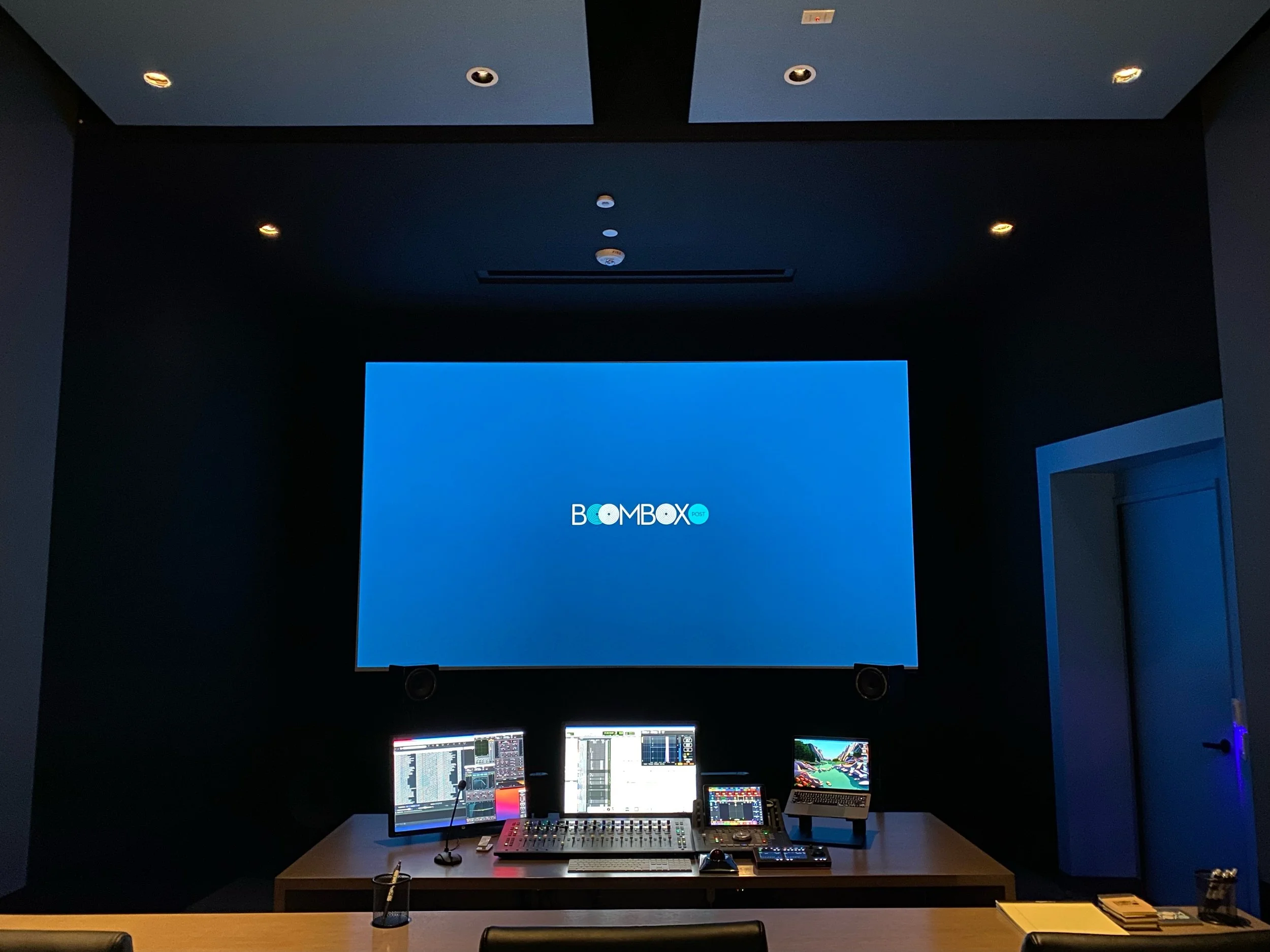Mixing for multiple mediums is difficult. What once was a straight forward process (project A is for theatrical release, project B is for TV, etc) has evolved over the years to become much more complicated. Every film, though it may start out in theaters, will undoubtedly also be consumed on an iPhone.
I for one think we need to stop panning materials like it’s all going to a giant screen. I try to live life by the “everything in moderation” mantra and I think it serves us well to approach mixing for multiple mediums in this way.
By the beginning of this year, Boom Box Post had fully moved into our new facility with three Atmos mix stages, three 5.1 mix suites, eight sound design/editorial suites, and full client amenities. So, when Women’s Audio Mission reached out to revisit the idea of having an in-person workshop focused on sound for television and film that would meet the needs of their Los Angeles membership base, we had the perfect space to accommodate it.
2025 is officially here! One of my New Year’s resolutions is to make a conscious effort to improve my speed and efficiency in my sound work. It’s easy to get stuck in your old ways, especially if you’ve been working with Pro Tools for quite a while. Since there are a million ways to achieve the same result, what better time than now to start exploring other techniques and form new habits in your workflow?
When done right, the music montage is a wonderful thing. The right song or classic bit of score can bring an audience to an entirely new emotional level. If you don’t believe me, go watch the first ten minutes of Pixar’s “Up,” some incredibly devastating filmmaking; a master course in montage.
So how do you approach music montages in your mix? What are some of the basic techniques and rules to follow? Below, I lay out my best practices.
As a mixer of a lot of Disney content, I have years of experience mixing musical numbers (or songs, as we call them). As someone who came into post-production sound mixing from a classical music and music engineering and mixing background, this is one of my favorite parts of the job. It brings me so much joy to have the privilege to integrate amazing Broadway-style musical numbers and carefully crafted pop songs of all genres into the stories that kids consume. A great song can be a wonderful extension of the story–not just adding a little pizzazz, but bringing the entire story to new depths.
A few weeks ago, Chad Anderson of Filmmaker U invited me to chat with him about sound for animation. Filmmaker U is a website that creates courses for film professionals to deepen and diversify their skillsets. So, as a huge proponent of being a lifelong learner, I was very excited to add the topic of animation sound to that knowledge base for their audience!
By the beginning of this year, Boom Box Post had fully moved into our new facility with three Atmos mix stages, three 5.1 mix suites, eight sound design/editorial suites, and full client amenities. So, when Women’s Audio Mission reached out to revisit the idea of having an in-person workshop focused on sound for television and film that would meet the needs of their Los Angeles membership base, we had the perfect space to accommodate it.
Starting your first 360 audio project can be a bit overwhelming. I decided to focus my Lunch and Learn on some essential concepts to help you get started. This post is specifically about designing for 360 video or VR experiences that are intended to be heard through headphones.
Everyone knows that the key to becoming a quicker editor is learning and utilizing keyboard shortcuts, but Pro Tools is such a powerful piece of software that even the most seasoned editors or mixers might not know all the keyboard shortcuts that can help speed up their workflow. Hopefully after reading this blog. post you can walk away with at least one Pro Tools tip or trick you didn’t know before.
The first mix of any project, especially long-term projects like a television series, is always the hardest. Everyone involved in the sound package has done their best to put creative high-quality sound into the session. The mixing team have put in the effort to create a mix that they believe is of a quality that could air on television right out of the box. But, then the clients step into the room.
As a mixer, I try my best to do justice to the content. I use all of my tools to achieve balance and clarity. But the clients always have their own unique agenda of what’s important to the story for them, which plot-points need a little extra clarity from the sound, or which emotional beats are essential for the music to carry. There is no knowing these priorities and sensibilities until you’ve sat down in a room with the clients and gone through their notes one by one.
We recently finished construction on our brand new post sound facility in Burbank, CA. One of our top priorities was to have multiple mix stages under our roof, all of which ready for Dolby Atmos. The way we saw it, we might as well be on the forefront of this emerging format. Building a mix stage is challenging enough, but adding in the extra Atmos considerations meant we would be faced with lots of opportunities to learn. Lucky for us, we are all about continuing to learn here at Boom Box Post! It’s in that spirit that I want to share with you some of the details of our journey.
Do you remember watching TV or listening to the radio and it drove you crazy that the audio levels were extremely different whenever something different came on or if you changed the channel? We no longer have this issue. Here is why!
When I first started working at Boom Box Post, I had a hard time understanding what exactly took place during each step of the post-production process. With so many different steps in our workflow, it was very easy for me to get lost in the order of events. Oftentimes, I mixed up editor spots with client spots, editor previews with client previews, and don’t even get me started on editorial fixes and when those were supposed to happen…
Creating an exciting sound mix for television can be a HUGE challenge. Way back in 2020, I explained the basic structure of my mixing process, but there is a lot more to mixing than just following a list of steps. I also like to consider goals or objectives I want to achieve during the process. These vary from project to project, but here are three mixing objectives I often keep in mind while I work through each mix.
If you missed Jeff’s big announcement in his blog post Introducing Boom Box Post Verdugo, we are currently building a new facility that will be all our own! We are in the home stretch of construction of our new studio which will feature three Atmos-ready mix stages. We are hoping to complete construction in about a month, and then we will move on to fabric, wiring, and gear installation on the stages. Because this process has been fascinating to us as first-time mix stage builders, I thought I would share our progress thus far with all of you.
Whether you’re mixing for film in 5.1 surround or Dolby Atmos, it’s important to consider a key element of human auditory perception: localization. Localization is the process by which we identify the source of a sound. We may not realize it, but each time we sit down to watch a movie or TV-show, our brains are keeping track of where the sound elements are coming from or headed towards, like spaceships flying overhead, or an army of horses charging in the distance. It is part of the mixer’s role to blend the auditory environment of a show so that listeners can accurately process the location of sounds without distraction or confusion. Here are some psycho-acoustical cues to consider when mixing spatial audio.
If you’re like me, then you think being a re-recording mixer sounds not only intimidating but also very confusing. I think of the giant mixing board with a ton of buttons and nobs on it. YIKES. I thought the best way to get my questions answered was to ask one of our re-recording mixers, Jacob! He has his hands in all of our shows so he definitely has the lowdown. Let’s jump right in!
As some of you may know, I’m a long-time sound designer and supervising sound editor, but I just started mixing a few years ago. While attending mixes as a supervisor definitely gave me a window into best practices for sound design success (aka how to make sure your work actually gets played…audibly), I got a whole new vantage point for what to do (and not do) once I started having to dig through sound design sessions myself! So, while I am a fledgeling mixer and you should always speak directly to the mixer working on your project before making decisions or altering your workflow, I feel that I am qualified to share my personal preferences and experiences. Take this as the starting point for a conversation—a window into one mixer’s mind, and hopefully it will spark great communication with your own mixer.
I have been a sound effects editor and supervising sound editor for a long time now. But, I have recently begun mixing a television series here at Boom Box Post. I am enjoying how much I learn each and every time that I sit down at the board, and am my no means ready to start spouting mixing advice to anyone. But, I can say that I’ve come to appreciate certain editorial practices (and absolutely abhor others!) through my new vantage point as a mixer. Things that I thought of as a nice way to make your mixer happy have turned into practices that are essential to me being able to start my mixing day right. Seriously, these five things can be the difference of hours added to my predub day. So, here are five editorial practices that I’ve realized are absolutely essential to a smooth mix.
I’ve been very fortunate to have the unique opportunity to see both sides of the post production coin, if you will. Being this sort of sound effects editor/re-recording mixer hybrid has really propelled my understanding of the post production sound process and has expanded the depth at which I create that sound tenfold. I’ve come to find that the two roles compliment each other and I find myself using skills from one discipline in that of the other (and vice versa) on a daily basis. First and foremost, I will always have an affinity for sound effects editing. The single most mixer-related skill that has improved that affinity, and one that I cannot edit without, is panning automation. More specifically, panning automation in a 5.1 or surround space.





















